A trip to China offers an unparalleled journey through one of the world’s most diverse and culturally rich nations, blending ancient wonders with cutting-edge modernity. From walking along the awe-inspiring Great Wall near Beijing and exploring the majestic Forbidden City, to witnessing the silent army of Terracotta Warriors in Xi’an, China immerses travelers in over 5,000 years of continuous civilization. Nature lovers can marvel at the surreal landscapes of Zhangjiajie’s sandstone pillars, cruise along the picturesque Li River in Guilin, or hike through the misty granite peaks of Huangshan. In Chengdu, visitors can get up close with giant pandas and savor the fiery delights of Sichuan cuisine, while Shanghai dazzles with its futuristic skyline, vibrant nightlife, and rich colonial history along the Bund. For a truly spiritual experience, a journey to Tibet unveils the mystical grandeur of the Potala Palace and the serenity of high Himalayan landscapes. Whether you seek ancient heritage, natural beauty, culinary adventures, or dynamic cities, China offers a travel experience as vast and profound as the country itself.
🏯 1. Beijing (Capital City)
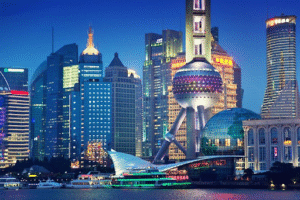
Beijing, the capital of China, is a city where ancient imperial grandeur meets modern dynamism, offering travelers a powerful glimpse into the heart of Chinese civilization. At its core lies the Forbidden City, a sprawling palace complex that once housed emperors for nearly 500 years, surrounded by the vast Tiananmen Square, a symbol of China’s modern political history. Just north, the Great Wall of China stretches across rugged mountains, providing breathtaking views and a sense of awe at this engineering marvel. The Temple of Heaven, with its symmetrical architecture and deep spiritual significance, reflects ancient Chinese cosmology, while the serene Summer Palace offers an escape with its tranquil lakes and classical gardens. Beyond its heritage, Beijing pulses with contemporary life—bustling hutongs, cutting-edge art districts, and world-class cuisine—from traditional Peking duck to modern fusion. A visit to Beijing is not just a journey through time, but a dive into the essence of China’s past, present, and future.
The Great Wall of China – Iconic and ancient, stretching thousands of miles.
Forbidden City – The world’s largest palace complex, once home to emperors.
Temple of Heaven – Architectural masterpiece and spiritual site.
Summer Palace – Beautiful imperial gardens and lake.
🏙️ 2. Shanghai
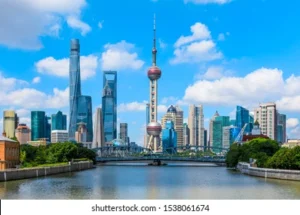
Shanghai, China’s largest and most cosmopolitan city, is a dynamic fusion of East and West, tradition and innovation. The iconic Bund showcases colonial-era architecture facing the futuristic skyline of Lujiazui, where skyscrapers like the Shanghai Tower and Oriental Pearl TV Tower dominate the cityscape. As a global financial hub, Shanghai offers cutting-edge infrastructure, luxury shopping, and a vibrant nightlife, while still preserving its rich cultural heritage in places like Yu Garden, a classical Chinese garden in the heart of the Old City. The Shanghai Museum and China Art Museum highlight the city’s role as a cultural capital, and neighborhoods like Tianzifang and Xintiandi blend historic charm with trendy cafes and art boutiques. Whether you’re exploring traditional shikumen architecture or cruising the Huangpu River under neon lights, Shanghai delivers a fast-paced, sophisticated experience that captures the spirit of modern China.
The Bund – Historic waterfront with European architecture.
Oriental Pearl Tower – Famous TV tower with panoramic views.
Yu Garden – Classical Chinese garden in the Old City.
Shanghai Museum & Art Scene – Modern and traditional culture blend.
🏺 3. Xi’an
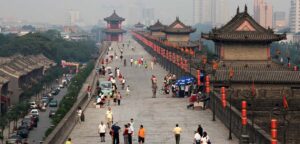
Xi’an, one of China’s oldest and most historically significant cities, served as the capital for 13 dynasties and marks the starting point of the ancient Silk Road. Its most iconic attraction is the Terracotta Army, a massive underground army of thousands of life-sized clay soldiers built to guard the tomb of China’s first emperor, Qin Shi Huang. The city is encircled by the Ancient City Wall, one of the best-preserved in the world, offering panoramic views and a unique opportunity to walk or bike along its ramparts. Within the city lies the vibrant Muslim Quarter, a cultural melting pot known for its lively street markets and flavorful local cuisine. Landmarks like the Big Wild Goose Pagoda reflect Xi’an’s importance as a center of early Chinese Buddhism. With its deep historical roots and living traditions, Xi’an is a compelling destination that brings China’s imperial past vividly to life.
Terracotta Army – Thousands of life-sized warriors guarding an emperor’s tomb.
Ancient City Wall – Well-preserved fortification you can walk or bike.
Big Wild Goose Pagoda – Important Buddhist site.
🐼 4. Chengdu
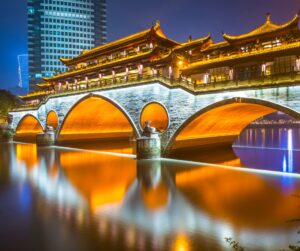
Chengdu, the capital of Sichuan Province, is a captivating blend of cultural richness, natural beauty, and culinary excellence. Renowned as the home of the giant panda, Chengdu’s Panda Research Base offers an up-close experience with China’s most beloved animal in a well-preserved, natural setting. Beyond its wildlife fame, Chengdu is the heartland of Sichuan cuisine, where bold flavors and signature dishes like hot pot and mapo tofu draw food lovers from around the world. The city’s laid-back lifestyle is reflected in its traditional teahouses, historic Jinli Ancient Street, and scenic parks like People’s Park, where locals gather for tea, music, and mahjong. Just outside the city lies the awe-inspiring Leshan Giant Buddha, the world’s largest stone Buddha statue carved into a cliffside. As a UNESCO City of Gastronomy with a deep connection to both tradition and innovation, Chengdu offers a uniquely authentic window into China’s southwest.
Giant Panda Breeding Research Base – See pandas up close.
Jinli Ancient Street – Traditional snacks, culture, and souvenirs.
Leshan Giant Buddha (nearby) – The world’s largest stone Buddha statue.
🏞️ 5. Zhangjiajie
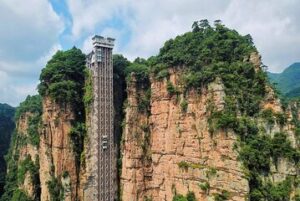
Zhangjiajie, located in Hunan Province, is one of China’s most breathtaking natural wonders, famed for its otherworldly landscapes that inspired the floating mountains in the movie Avatar. The centerpiece is the Zhangjiajie National Forest Park, a UNESCO World Heritage Site known for its towering quartz-sandstone pillars, dense forests, and dramatic cliffs that rise through mist and clouds. The park is home to the Bailong Elevator, the world’s tallest outdoor elevator, and the Zhangjiajie Glass Bridge, a record-breaking, transparent walkway suspended over a deep canyon—both offering adrenaline-pumping views. Adventurers can explore scenic trails, cable cars, and cliffside walkways that wind through natural stone arches and hidden valleys. Beyond the park, attractions like Tianmen Mountain with its heavenly “Stairway to Heaven” and skywalks carved into cliffs elevate the experience further. Zhangjiajie delivers a surreal, almost mythical encounter with nature, making it one of China’s most unforgettable destinations.
Zhangjiajie National Forest Park – Incredible sandstone pillars (inspired Avatar).
Glass Bridge – World’s longest and highest glass-bottomed bridge.
🌄 6. Guilin & Yangshuo
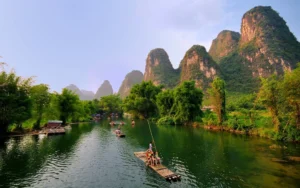
Guilin and Yangshuo, located in southern China’s Guangxi Province, are renowned for their surreal and poetic karst landscapes, often celebrated in traditional Chinese paintings and poetry. The Li River, winding between dramatic limestone peaks and lush rice paddies, offers one of the most iconic river cruises in the world, connecting Guilin to the picturesque town of Yangshuo. Guilin boasts natural wonders like Reed Flute Cave, filled with illuminated stalactites and stalagmites, and Elephant Trunk Hill, a symbol of the city. In Yangshuo, visitors can immerse themselves in rural charm—cycling through tranquil villages, bamboo rafting on the Yulong River, or watching the famous Impression Liu Sanjie light show set against a natural mountain backdrop. With a harmonious blend of natural beauty, traditional culture, and outdoor adventure, Guilin and Yangshuo offer an enchanting escape into the heart of China’s scenic countryside.
Li River Cruise – Spectacular karst mountain scenery.
Yangshuo Countryside – Ideal for cycling, bamboo rafting, and peaceful views.
🏔️ 7. Tibet (Lhasa)
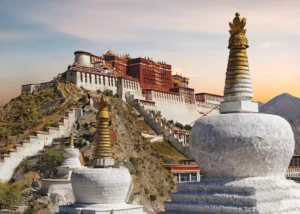
Tibet’s capital, Lhasa, stands as a profound spiritual and cultural epicenter high on the Tibetan Plateau, embodying centuries of Buddhist tradition and Himalayan mystique. Dominating the city skyline is the majestic Potala Palace, the former winter residence of the Dalai Lama and a UNESCO World Heritage Site, renowned for its intricate architecture, sacred relics, and panoramic views. The Jokhang Temple, considered the holiest site in Tibetan Buddhism, attracts pilgrims from across the region who circumambulate its ancient halls in devotion. Lhasa’s vibrant Barkhor Street bustles with traditional markets, prayer wheels, and incense, offering a vivid glimpse into Tibetan daily life. The city serves as a gateway to the breathtaking landscapes of the Himalayas, including sacred mountains and remote monasteries, making Lhasa not only a center of religious reverence but also an awe-inspiring destination for adventurous travelers seeking cultural depth and natural grandeur.
Potala Palace – Former home of the Dalai Lama.
Jokhang Temple – Sacred Tibetan Buddhist site.
Everest Base Camp (Tibet side) – For the adventurous.
🏖️ 8. Hainan Island
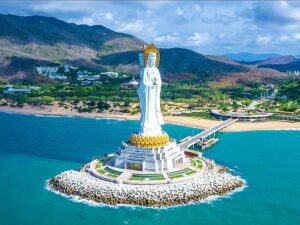
Hainan Island, often dubbed the “Hawaii of China,” is a tropical paradise located in the South China Sea, offering a unique blend of pristine beaches, lush rainforests, and vibrant cultural diversity. Its capital, Haikou, and the resort city of Sanya attract visitors with warm year-round weather, crystal-clear waters, and world-class resorts ideal for relaxation and water sports such as snorkeling, diving, and surfing. Beyond its coastal allure, Hainan is home to rich ecological reserves like Yanoda Rainforest Park and culturally significant Li and Miao ethnic minority villages, providing authentic experiences of China’s southern heritage. With its rapid development as a free trade zone and tourism hotspot, Hainan perfectly balances modern amenities with untouched natural beauty, making it an increasingly popular destination for both leisure travelers and eco-adventurers seeking a tropical escape within China.
Sanya – China’s top beach destination with tropical resorts.
Rainforest parks and water activities – Great for nature and relaxation.
🧱 9. Huangshan (Yellow Mountains)

Huangshan, or the Yellow Mountains, is one of China’s most iconic natural landmarks, celebrated for its dramatic granite peaks, ancient pine trees, and ethereal seas of clouds that have inspired countless Chinese painters and poets for centuries. Rising sharply from the mist, the jagged summits create a surreal and almost mystical landscape that transforms with the shifting light and weather, offering breathtaking views at every turn. The area is also rich in cultural heritage, with nearby ancient villages like Hongcun and Xidi preserving traditional Anhui architecture and local customs. Renowned for its challenging hiking trails, scenic cable cars, and natural hot springs, Huangshan is both a natural wonder and a cultural treasure, drawing nature lovers, artists, and adventurers seeking to experience the quintessential beauty of China’s mountainous terrain.
Dramatic peaks, pine trees, and sea of clouds – Iconic Chinese landscape painting scenery.
Nearby ancient villages – Like Hongcun and Xidi.
🛕 10. Hangzhou & Suzhou
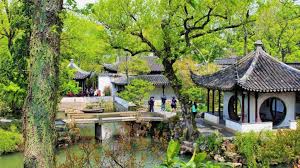
Hangzhou and Suzhou, two jewels of eastern China, epitomize classical Chinese elegance through their exquisite gardens, historic waterways, and rich cultural legacies. Hangzhou’s famed West Lake enchants visitors with its serene waters, ancient temples, pagodas, and meticulously designed landscapes that have inspired poets and artists for centuries. Just a short journey away, Suzhou is celebrated for its classical gardens, such as the Humble Administrator’s Garden and Lingering Garden, masterpieces of landscape architecture showcasing harmony between nature and human creativity. Known as the “Venice of the East,” Suzhou’s intricate network of canals, traditional stone bridges, and silk industry heritage complement its timeless charm. Together, these cities offer a refined and immersive experience of China’s historical sophistication, combining tranquil natural beauty with vibrant cultural traditions.
Hangzhou’s West Lake – Peaceful lake surrounded by gardens and temples.
Suzhou’s Classical Gardens – Exquisite landscaping and historic canals.
